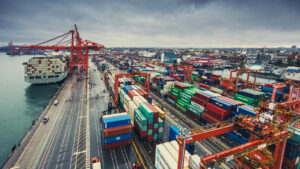The Philippines’ goods trade deficit widened in 2024, the largest trade deficit in more than two years, as imports increased while exports continued to decline, the Philippine Statistics Authority (PSA) said on Friday.
Preliminary data from the PSA showed the country’s full-year trade balance – the difference between the value of exports and imports – grew 3.1% year-on-year to a deficit of $54.21 billion in 2024, compared to a $52.59 billion deficit a year earlier.
The latest figures indicate the lowest trade gap since the 2022 deficit of $57.65 billion.
Goods exports fell 0.5% to $73.21 billion in 2024, below the Development Budget and Coordination Committee’s (DBCC) 4% growth forecast for 2024.
A year earlier, exports fell by 7.5%.
Meanwhile, imports rose 1% year-on-year to $127.43 billion in 2024, an improvement from the 8% contraction in 2023. Import growth fell short of the DBCC growth target of 2%.
In December, the country’s goods trade deficit fell to $4.14 billion from $4.85 billion in November.
This was the smallest trade deficit in nine months or since the $3.35 billion deficit in March 2024.
Goods exports fell 2.2% to $5.66 billion this month, slower than November’s 8.6% contraction.
In value terms, December exports were the lowest in six months, or since $5.57 billion in June 2024.
Similarly, imports shrank 1.7% to $9.79 billion, slower than the 4.1% decline a month earlier.
The import value was the lowest in nine months or since $9.57 billion in March 2024.
“In recent years, both exports and imports have been quite weak and hardly drivers of economic growth,” said Diwa C. Guinigundo, country analyst at GlobalSource Partners.
Mr Guinigundo added that external trade has minimal net impact on the economy.
“Weak exports are being overshadowed by higher imports, although these have been quite sluggish recently. [while] modest imports are also indicative of weak manufacturing and business activities,” he said. Guinigundo said in a Viber message.
Moreover, he noted that the Philippine economy has experienced some slowdown over the past two years, causing it to fall short of the lower end of growth targets.
In 2023, the Philippine economy grew by 5.5%, significantly slower than 2022’s 7.6% growth.
This was the weakest growth in three years since the 9.5% slump in 2020.
The PSA will report fourth-quarter and full-year gross domestic product on Thursday, Jan. 30.
Manufactured goods, which account for more than three-quarters of exports, fell 2.6% last year to $58.34 billion.
Electronic products, which make up most industrial goods and more than half of all exports, fell 6.7% to $39.08 billion. Semiconductors also fell 13.5% to $29.16 billion.
The United States remained the top destination for Philippine goods in 2024, with exports worth $12.12 billion or 16.6% of total export sales.
It was followed by Japan with $10.33 billion (14.1% share), Hong Kong with $9.6 billion (13.1%), China with $9.44 billion (12.9%) and South Korea with $3 .57 billion (4.9%).
Imports of capital goods fell by 0.1% to $35.7 billion.
On the other hand, imports of raw materials and semi-finished products increased by 2% to $46.35 billion.
Imports of consumer goods also rose 5.6% to $25.81 billion, while imports of mineral fuels, lubricants and related materials fell 5.2% to $19.06 billion.
By commodity group, electronic products had the highest import value of $27.37 billion in 2024, up 2.7% from $26.64 billion a year ago.
China was the largest source of imports this year with goods worth $32.81 billion, accounting for 25.8% of the total import bill.
It was followed by Indonesia with $10.55 billion (8.3% share), Japan with $10.07 billion (7.9%), South Korea with $9.63 billion (7.6%) and the United States with $8.17 billion (6.4%).
Jesus L. Arranza, president of the Federation of Philippine Industries, said in a phone call that illegal trade and imports of consumer goods such as rice and sugar contributed to widening the gap for the year.
He added that the increase in smuggling in the country has led to a decline in domestic production.
“The president wants to stabilize the price of rice and the price of sugar… We also want to reduce prices for consumers. Because consumers have already made noise,” he said in a mix of Tagalog and English.
Mr Arranza also said that the narrowing of the gap in December was due to the fact that goods were already being delivered in the October-November period in anticipation of the end of the season.
Mr. Guinigundo said while it is good that U.S. tariff increases will not be applied to Philippine exports, they could impact Philippine exports to China, which participates in the Southeast Asian country’s semiconductor market.
“This would require a rethink by Philippine exporters on their market focus,” Mr. Guinigundo said. — Pierce Oel A. Montalvo

